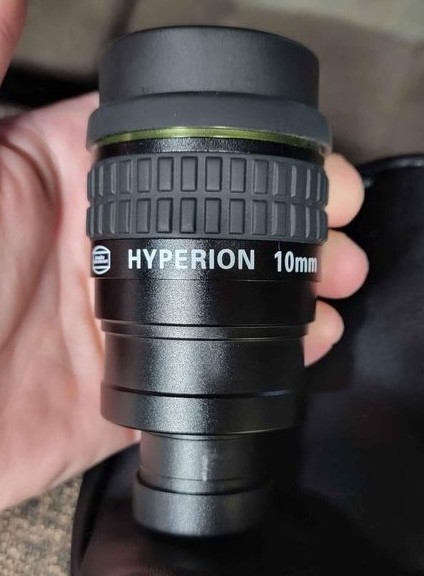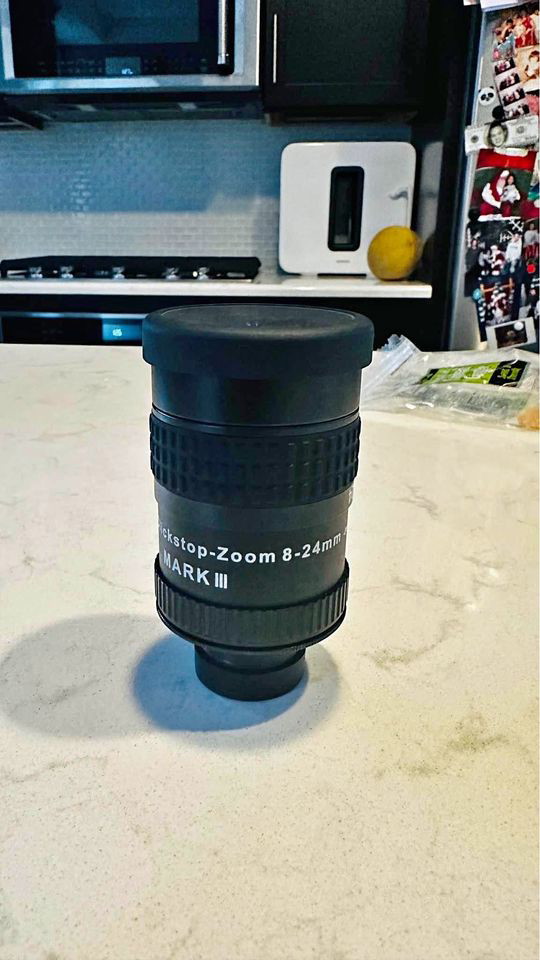Baader’s Hyperion line was introduced in the mid-2000s to provide quality, relatively inexpensive wide-field eyepieces that fit both 1.25” and 2” focusers without the use of adapters.

- Eye Relief: 20mm (17mm w/24mm Hyperion)
- Apparent field of view: 68 degrees (61 degrees with a 21mm Hyperion)
- Weight: Between 11.6-14.7 ounces (328-417 grams)
- Coatings: Fully broadband multi-coated
Available Focal Lengths: 24mm, which uses a slightly different optical design than the other six, which are 21mm, 17mm, 13mm, 10mm, 8mm, and 5mm. A 3.5mm was made, but it was discontinued due to a lack of demand at that focal length for such an eyepiece; it is really only useful with small refractors at moderate f/ratios.
Which to buy?
I would recommend steering clear of the Hyperions if you use a telescope with a focal ratio below f/6, particularly a Newtonian, though you may want to give the 5mm a shot, and the 17mm should work alright if you have a coma corrector handy.
If you’re using a longer refractor or catadioptric, I would recommend obtaining the 17mm Hyperion first. It’s the best in the line and a good moderate-to-low-power eyepiece. If you’ve already got a 25mm Plossl eyepiece or the like with your scope, the 17mm Hyperion will complement it nicely without replacing it.
The 5mm Hyperion is a great planetary eyepiece, but it’s at about the maximum magnification an f/10 Schmidt-Cassegrain can handle and above the maximum a longer Maksutov can. The 8mm Hyperion is probably better-suited for high power with an SCT, even if its performance is slightly inferior, as it offers a more sane magnification choice.
After that, I would recommend obtaining the 13mm, 10mm, and 8mm, if you haven’t already, in that order. To me, the 21mm doesn’t fill enough of a useful niche, and as I’ve explained later in the review, I do not recommend the 24mm Hyperion for any telescope due to the lack of sharpness.
Baader also offers a Hyperion Zoom, which is similar in name only, and two “Hyperion Aspheric” eyepieces with 72-degree fields at 31mm and 36mm focal lengths. The Hyperion Aspherics are native 2” format and really designed to be used as 2” eyepieces only, as they will vignette with the included 1.25” adapters (particularly the 36mm). They share little in common with the standard Hyperions, and as such, they will not be discussed further in this review.

Analysing the Features
The Hyperions all have very large eye lenses and long eye relief. This makes them ideal for those who have astigmatism and must wear eyeglasses. The Hyperions also come with Baader’s Phantom Group multi-coatings for minimal light loss and scattering.
In addition, the Hyperions’ unique optical design allows one to insert “fine tuning rings” between the upper and lower lens groups on all but the 24mm. The fine tuning rings shorten the focal length of the eyepieces similarly to a Barlow but simply by increasing the spacing between the lens groups. However, the tuning rings are costly, and changing them in the dark is a worrying process that may leave dust/dirt inside your eyepiece, so I’d recommend not bothering to fool around with the fine tuning rings and simply using the eyepieces at their fixed focal lengths.
While Baader claims you can remove the lower lens group entirely from the standard Hyperions and use them as 2” wide-field eyepieces, doing so results in a rather aberration-filled eyepiece with almost no eye relief, rendering it almost useless. Don’t try it.
The Hyperions’ eyecups are removable, exposing M43 threads. You can buy a camera adapter and shoot afocally through the eyepiece if you want to, but there is little advantage in shooting afocally anymore for serious astrophotography, and I would not recommend spending hundreds of dollars on gear to do so.
The Performance Comparison
The Hyperions are relatively inexpensive wide-fields, and due to their low prices and the design requirement of large eye lenses and long eye relief, which limits other aspects of the optical design, they are really meant for slower f/ratio telescopes.
Hyperions will do great at f/15 or f/10, and okay down to f/6. But below f/6, the edge-of-field sharpness begins to fall off, with the eyepieces displaying the edge-of-field astigmatism all-too-typical of less expensive wide-field eyepieces. The 21mm, 17mm, 13mm, 10mm, and 8mm Hyperions exhibit noticeable “pin-cushion” distortion (field curvature) in fast scopes, which may or may not bother you.
The 24mm has probably the least field curvature of any of the Hyperions—probably thanks to the different optical design—but also the worst off-axis performance, even in relatively slow instruments. The majority of amateur astronomers strongly dislike it. Additionally, you cannot take advantage of Baader’s fine tuning rings with the 24mm, unlike with the other Hyperions. Overall, I would not recommend the 24mm Hyperion for use with any telescope.
The 21mm Hyperion, on the other hand, is excellent. The field of view on it is actually about 61 degrees, not the 65 Baader claims. Baader’s restriction of the outer 3.5 degrees of the field definitely cleans up the edge sharpness (even though it is simply masking the problem, not removing it outright). Performance in fast scopes is surprisingly decent, though again, it’s unfairly boosted by the smaller apparent field. If you’re able to live with the restricted field compared to the other Hyperions, I highly recommend the 21mm.
The 17mm Hyperion is largely regarded as the best eyepiece in the set, with some calling it a “poor man’s 17.3mm TeleVue Delos”, as it has a similar field of view, focal length, and nearly as good performance as said eyepiece (the 17.3mm Delos is regarded as one of the weaker eyepieces in its family, however). The field stop is the most well-defined of any of the Hyperion eyepieces, and the 17mm has the best off-axis sharpness.
The 13mm Hyperion has very good performance in slow instruments of f/8 or above, but the worst performance at even moderately fast focal ratios. I found it to be a very good fit for my 8” SCT, but it is probably not a good choice for most Newtonians or moderately fast refractors.
The 10mm, 8mm, and 3.5mm Hyperions have more or less the same performance: not amazing in fast scopes, pretty good at f/6 and above, and spectacular in catadioptrics and refractors at f/10 or above. The 5mm Hyperion seems to have slightly less field curvature and off-axis aberrations than the other <13mm Baaders, and you could potentially get away with using it in a fast Newtonian.
What’s the bottom line?
The Baader Hyperions (apart from the 24mm) are definitely worth your money if you do not use a fast Newtonian and are particularly well-suited for those with astigmatism or otherwise require long eye relief. They are definitely an improvement on the inexpensive Plossls and Kellners, and wide-field jobs supplied with most telescopes, and maybe all you ever need. I highly recommend the 17mm and 5mm Hyperions in particular.

Thanks for the review,I’m a very amateur beginner.ive got a nexstar evolution 5,from what you have said ,these eyepieces will be good.
excellent review and thanks
I’m looking to add the 8, 10 and 13….to my Celestron Evolution 6 f/10
Where would you rate these eyepieces to the Celestron X-cel and the Luminos?
Really different use cases. The Luminos eyepieces have some edge of field brightening issues but have a wider AFOV. The X-Cels are on par in sharpness but cheaper and narrower field.
Hugely thorough review! Thank you, this has probably saved me from buying one as I have a Newtonian.
Hi, I’m new to astronomy and have just purchased a Discovery 150P.
You don’t seem to recommend these for f5 reflectors.
What brand/type eyepieces would you recommend & why?
Thanks
The correction of the Hyperions isn’t great with fast scopes and they have a lot of edge-of-field astigmatism. The Explore Scientific 68 or 82-degrees, or Meade UWA eyepieces, have better correction for fast scopes.
For a 8 inch f/6 newtonian ,which would be the best branded eyepieces for high power(5 mm) and moderate power (10 mm) .
Is it better to invest in a separate 5 mm wide angle eyepiece or barlow a 10 mm piece
,
I gotta favorite this site it seems extremely helpful handy